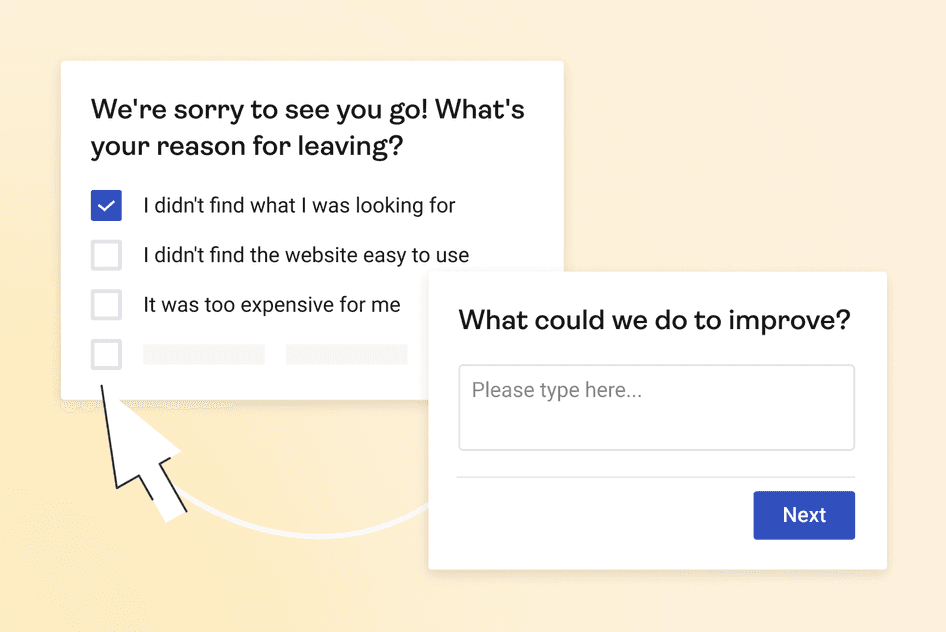Learn / Survey Templates / Survey Template
Exit-intent survey
Gather feedback before visitors leave your site and reduce your bounce rate
Get started with this template today.
Every customer interaction ends in either a sale or a lesson. An exit intent survey, sometimes called an ecommerce churn survey, or simply an exit survey, captures feedback as someone is leaving your website. Once you know why customers leave, you can mitigate it and reduce your bounce rate.
For example, if someone noted in their exit intent survey that they were leaving the page because it didn’t have enough information, you could redesign the page to add more details in a visible spot.
Why should you use a website exit survey?
Asking your site visitors why they’re bouncing off a page will help you:
Improve the user experience: discover whether a usability issue is preventing website visitors from experiencing your site the way you intended, and let them suggest UX improvement ideas
Boost your conversion rates: learning why users are churning is the first step to understanding how you can prevent them from dropping off. Identify the barriers and blockers preventing users from converting, then remove those.
Keep your users engaged with your brand: website visitors might not convert immediately—especially during their first visit. Use an exit survey to convince them to give you their contact details so they can become part of your lifecycle marketing campaigns. A best practice when doing this is to offer them an incentive that provides them with value: an invitation to a webinar, a downloadable checklist, or a 1:1 call are common examples.
When should you use an exit intent survey?
Improving your website and ecommerce experience means you need to know the good and the bad from real customer interactions. Reading what caused someone to want to leave your page helps you:
Reduce your bounce rate by finding and changing problem areas
Learn what customers value so you can feature it prominently
Understand how potential customers compare you to competitors
Where should you place an exit survey on your website?
Depending on which step of the marketing or sales funnel you’re trying to improve—and the nature of your business—you can place an exit-intent survey on different web pages:
Checkout page: ecommerce stores stand much to gain by using a shopping cart abandonment survey to understand why users didn’t convert during the checkout process. This may lead you to realize that your payment system doesn’t support some users’ credit cards or that they worry about hidden fees.
Product page: similarly, online store owners might want to place an exit survey on low-converting product pages. Customer feedback might hint at insufficient product descriptions, lack of high-quality pictures, or the absence of social proof like customer reviews.
Pricing page: for SaaS businesses especially, the pricing page is one of the main sources of signups. Placing an exit-intent survey on this page might reveal that your prices are unclear or highlight opportunities to improve your packages.
Landing pages: to lower the CAC of your paid marketing campaigns, you need to optimize your landing pages. Feedback from users who failed to convert might help you improve those pages, perhaps by including testimonials about your product on the page or by better showcasing its unique selling points.
Homepage: this is usually one of the most visited pages on any site, especially for users who interact with you for the first time. While they may simply not be ready to convert just yet, a website exit survey placed on this highly visited page may prompt them to keep in touch, either by asking them to join your email list or telling them about an upcoming online event you’re organizing.
What’s in the exit intent survey template?
Exit intent survey templates provide people with a selection of reasons they chose to leave a page, plus an opportunity to expand on their thoughts.
How to use what you learn in an exit intent survey
Once you collect exit intent data, here’s how to put what you’ve learned into action:
Prioritize updates based on churn
If you’re contemplating a few potential website projects, a persistent cause of churn can help you prioritize critical tasks. Turn website visitors into customers by tackling these conversion rate optimization opportunities first.
Find preferences across segments
Reviewing exit intent responses across customer segments reveals what each audience prioritizes, which can help you tailor designs and website flows. A/B test your designs based on respondents’ feedback and improve their customer experience.
Fix problem pages before they get out of control
Bounce rates and exit intent responses help you spot recurring issues, but sometimes you need more context. Recordings show you how visitors experience your website so you can determine what’s causing the problem.
Set up an exit intent survey in minutes
Getting started with an exit intent survey template is fast and easy. Start by clicking the ‘Get started with this template’ link at the top of the page.
Next, you’ll be asked to create an account and verify your email.
After you’re verified, the survey template will be ready for you to send to customers to start collecting insights.
However, you’ll also have the option to install the Hotjar tracking code on your site. This tracking code allows you to host the survey live on your site rather than via an external URL, which means you can place it on a particular page. The tracking code also gives you access to Hotjar’s features.
Don’t worry, installing the tracking code won’t slow your website down. And it doesn’t cost you anything (our free plans are free forever). Follow these steps to set up your full Hotjar account and install the tracking code, or simply use the Google Tag Manager integration.
FAQs
Get started with this template today.
